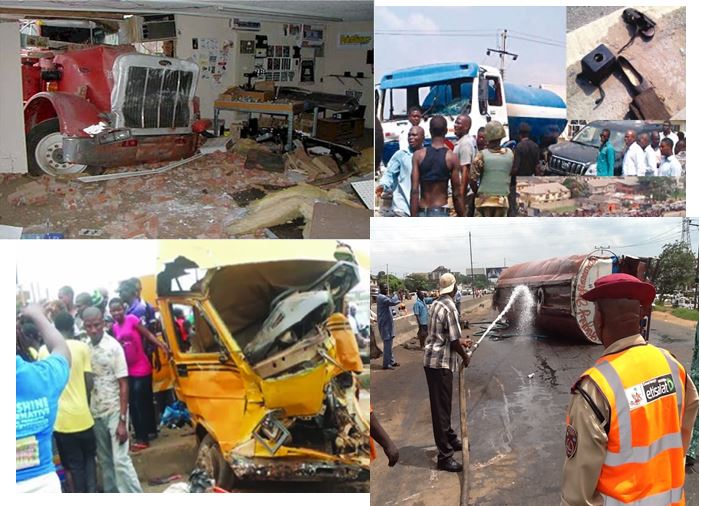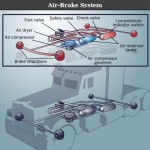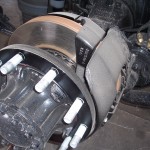
Over the past few days, two major accidents involving trucks occupied the front pages of the mainstream media. Both accidents resulted in substantial fatalities! In both cases too, the mainstream media reported that the trucks’ brakes had failed. In the accident that occurred at Oshodi, a tipper loaded with sand and said to belong to a Pentecostal church was reported to have lost control and it crashed into bystanders and stationary buses at the bus stop. Between 8 and 12 lives (depending on which media report you followed) were said to have been lost. The other accident had a water tanker running over some kids that were said to be crossing the road after some other private cars had stopped for them to cross. Between 1 and 4 lives (again depending on which report you read) went to the great beyond from that accident.
While Haulage Report Now mourns the souls that were needlessly wasted, these isolated incidents and several others that had happened in the past and many more that gone unnoticed prompted us to ask some fundamental questions:
Why and how do brakes fail?
Must brakes fail or in another sense, are brakes failure unavoidable?
Are brakes so delicately contrived that they are prone to malfunctioning at the slightest misjudment?
What can you do to avoid brake failure or what do you do when brake fail?
All these questions agitate the mind most especially when you consider the quantum of truck-related accidents attributed to brakes failure. In Nigeria for instance, about 58% of truck-related accidents are linked to brakes failure. In the United States, about 29% of truck-related accidents are attributed to brakes failure!
Whilst we would try to answer these probing questions leveraging on our experience and additional research, we are very hopeful that colleagues in the industry will bring their experience to bear by making substantial contribution to this topic. The whole intent basically is to increase safety awareness most especially with respect to braking system in trucks and to get us to begin to put our houses in order with a view to preventing similar occurrences in future.
But before we go further, it is most pertinent that we understand better the mechanism that is at the center of our discussion in this post. We believe that you can only manage what you know hence a proper understanding will assist us better in making tangible contribution.
And so we ask: How do brakes (especially truck brakes) work?
Most trucks and buses in recent history are fitted with the braking system otherwise referred to as the Air-Brake System and the most common of these isthe Foundation brakes found in most trucks and buses. Using the triple-valve principle, air builds up inside the brake pipes or air lines, releasing the brakes. Virtually all of the road-going vehicles equipped with air brakes have a graduated release system where a partial increase in pressure dictates a proportional release in brakes.
The following components are exclusive to a foundation air-brake system in a truck:
Air compressor: Pumps the air into storage tanks to be used in the brake system. Gears or a V-belt connect the air compressor to the engine. The compressor may be air cooled or coded by the engine cooling system. It may have its own oil supply or it may be lubricated by engine oil.
Air compressor governor: Controls the cut-in and cut-out point of the air compressor to maintain a set amount of air in the tank or tanks. When air tank pressure rises to the cut-out level (around 125 psi), the governor stops the compressor from pumping air and vice versa.
Air reservoir tanks: Hold compressed or pressurized air to be used by the braking system. The tanks will hold enough air so you can use the brakes several times even if the compressor stops working.
Drain valves: Compressed air usually has some water and compressor oil in it that is bad for the air brake system. For example, the water can freeze in cold weather and cause brake failure. Release valves in the air tanks used to drain the air when the vehicle isn’t in use. It could either be a manual or an automatic drain valve.
Foot valve (brake pedal): When depressed, air is released from the reservoir tanks. When pedal is pushed down hard, more air pressure is applied. Letting up on the brake pedal reduces the air pressure and release the brakes. Releasing the brakes lets some compressed air out of the system. This reduces the air pressure in the tanks. The air compressor must replace the expended air. If you press and release the pedal unnecessarily, you let out air faster than the compressor can replace it.
Brake chambers: Cylindrical container that houses a slack adjuster that moves a diaphragm or cam mechanism
Push rod: A steel rod similar to a piston that connects the brake chamber to the slack adjuster. When depressed, the brakes are released. If extended, the brakes are applied.
Slack adjusters: An arm connects the push rod to the brake s-cam to adjust the distance between the brake shoes
Brake S-cam: An s-shaped cam that pushes brake shoes apart and against the brake drum
Brake shoe: Steel mechanism with a lining that causes friction against the brake drum
Return spring: A stiff spring connected to each of the brake shoes that return the shoes to the open position when not spread by the s-cam or diaphragm.
At idle (foot off the brake and vehicle’s air system charged), air pressure overcomes the diaphragm or the s-cam is in the closed position, resulting in a released brake system. As soon as you depress the brake pedal, the air pressure decreases, turning the s-cam and spreading the brake shoes against the drum. The compressor refills the reservoir tanks and when you allow the pedal to retract, the air pressure increases back to the original state.
Dual Air Brake Systems
Most new generation heavy-duty trucks use dual air brake systems for safety. A dual air brake system has two separate air brake systems with a single set of brake controls. Each system has its own air tanks, hoses, and lines. One system operates the regular brakes on the rear axles; the other, the regular brakes on the front axle (and possibly one rear axle). Both systems supply air to the trailer (if there is one). The first system is the primary system; the other, the secondary system.
Before driving a vehicle with a dual air system, it’s expected that one should allow time for the air compressor to build up a minimum pressure of 100 psi in the primary and secondary systems. Watch the primary and secondary air pressure gauges (or needles, if the system has two needles in one gauge). Check the low air pressure warning light and buzzer. The warning light and buzzer should shut off when the air pressure in both systems rises to a value set by the manufacturer. This value must be greater than 60 psi.
The warning light and buzzer should come on before the air pressure drops below 60 psi in either system. If this happens while driving, stop right away and safely park the vehicle. If one air system is very low on pressure, either the front or rear brakes will not be operating fully. (This means you will take longer to stop and thus increasing the possibility of an accident.) Safety concern demands that the truck be brought to safe stop to get the air brake system fixed.
Emergency air-brakes
This complements standard air-brake systems and can be activated by pulling a button on the dash. Before you can drive a vehicle with air brakes, you must push in the emergency brake button to fill the system with air. As long as the emergency system is pressurized, the emergency brake will remain free. If the system has a leak, the pressure can decrease enough to engage the emergency brake. In addition, heavy trucks are often equipped with an exhaust brake that aids the braking process, but this relies on the engine, not the air-brake system.
Having gone through the above, there is an overriding temptation to conclude that the braking system has a very robust infrastructure with more than enough ‘fail-safe’ capacity inbuilt! But the reality does not support this hasty conclusion; so we are forced to ask; why do brakes fail or what makes brakes to fail?
CLICK HERE to Continue reading in Part Two.







Wow! Wonderful write up. With this, I can confidently say we now have a blog that cares about us! More ink to your pen in Haulage Report Now. Kudo!!
@Safeway Logistics; Thanks for your interest in our blog. Yes, concern for life is all that this blog is about. We will continue to seek ways of adding value to our haulage sector. You may want to check out other interesting posts too. Subscribing will also enable you to get fresh contents regularly. Thank you.
I quite agree with you that we now have a platform where issues and likely solutions that concerns logistics business can be discussed. it’s been long coming. thank God for this vision, at last we now have a platform where reasonable and productive discussion can take place instead of the usual PDP, APC, EFCC and corruption stories that has enveloped this country for a long period. kudos to Haulage Report Now.
@Megaload Trucking; Yes, it’s been a long time coming and we are happy and count ourselves highly privileged to have been found worthy to champion this cause. Thank you so much for taking the time to read and contribute to our blog. We will continue to do what we know how to do best and that is in giving good resources that can assist your business to grow. Thank you also for joining our list of subscribers. We appreciate you greatly. Thank you.